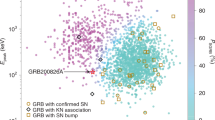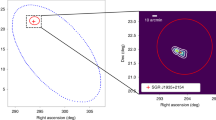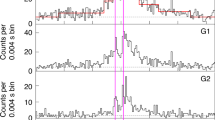Abstract
THE nature of γ-ray bursters—astrophysical sources that emit abrupt bursts of γ-rays—presents a long-standing question in high-energy astronomy. Soft γ-ray repeaters (SGRs) are distinguished from classical γ-ray bursters by the short duration, softer γ-ray spectrum and recurrent activity of their outbursts1–6. Millisecond-scale structure in these bursts suggests that SGRs are compact, and many models invoke neutron stars as the emitting objects1,5. This idea is supported by the association of two SGRs, SGR0526 – 66 (ref. 6) and SGR1806 – 20 (ref. 7), with supernova remnants, SNR N49 and the radio nebula G10.0 – 0.3 respectively. Very recently, Kulkarni et al.8,9 have suggested that a compact radio source in G10.0 – 0.3 corresponds to a young pulsar at the centre of this nebula, and can be identified with SGR1806 – 20. Here we report the detection of a burst from SGR1806 – 20 with the X-ray satellite ASCA10, which allows us to identify the burster with a new X-ray source which we designate AX1805.7 – 2025. The burst is coincident in time with that detected by the BATSE11,12 instrument on board the Compton Gamma Ray Observatory. This result provides strong evidence that SGRs are indeed neutron stars.
This is a preview of subscription content, access via your institution
Access options
Subscribe to this journal
Receive 51 print issues and online access
$199.00 per year
only $3.90 per issue
Buy this article
- Purchase on Springer Link
- Instant access to full article PDF
Prices may be subject to local taxes which are calculated during checkout
Similar content being viewed by others
References
Liang, E. P. & Petrosian, V. (eds) Gamma-Ray Burst (AIP Conf. Proc. No. 141, Am, Inst. of Phys., New York, 1986).
Kouveliotou, C. et al. Nature 362, 728–730 (1993).
Atteia, J-L. et al. Astrophys. J. 320, L105–L110 (1987).
Laros, J. P. et al. Astrophys. J. 320, L111–L115 (1987).
Kouveliotou, C. et al. Astrophys. J. 322, L21–L25 (1987).
Cline, T. L. et al. Astrophys. J. 255, L45–L48 (1982).
Kulkarni, S. A. & Frail, D. A. Nature 365, 33–35 (1993).
Kulkarni, S. A., Frail, D. A., Kassim, N. E. & Murakami, T. IAU Circ. No. 5879 (1993).
Kulkarni, S. A., Frail, D. A., Kassim, N. E., Murakami, T. & Vasisht, G. Nature 368, 129–131 (1994).
Tanaka, Y. et al. IAU Circ. No. 5880 (1993).
Kouveliotou, C. et al. IAU Circ. No. 5875 (1993).
Kouveliotou, C. et al. Nature 368, 125–127 (1994).
Norris, J. P., Hertz, P., Wood, K. S. & Kouveliotou, C. Astrophys. J. 366, 240–252 (1991).
Murakami, T., Nishimura, J., Kawai, N., Cooke, B. A. & Kato, M. Astr. Astrophys. 227, 451–455 (1990).
Stewart, R. T., Caswell, J. L., Haynes, R. F. & Nelson, G. J. Mon. Not. R. astr. Soc. 261, 593–598 (1993).
Author information
Authors and Affiliations
Rights and permissions
About this article
Cite this article
Murakami, T., Tanaka, Y., Kulkarni, S. et al. X-ray identification of the soft γ-ray repeater 1806 – 20. Nature 368, 127–129 (1994). https://doi.org/10.1038/368127a0
Received:
Accepted:
Issue Date:
DOI: https://doi.org/10.1038/368127a0
This article is cited by
-
Frame-dragging effects in obliquely rotating magnetars
Journal of Astrophysics and Astronomy (2021)
-
Magnetars: Properties, Origin and Evolution
Space Science Reviews (2015)
-
The Landau level-superfluid modified factor and the overal soft X/γ-ray efficiency coefficient of a magnetar
Astrophysics and Space Science (2011)
-
QED can explain the non-thermal emission from SGRs and AXPs: variability
Astrophysics and Space Science (2007)
-
XMM–Newton observations of soft gamma-ray repeaters
Astrophysics and Space Science (2007)
Comments
By submitting a comment you agree to abide by our Terms and Community Guidelines. If you find something abusive or that does not comply with our terms or guidelines please flag it as inappropriate.



